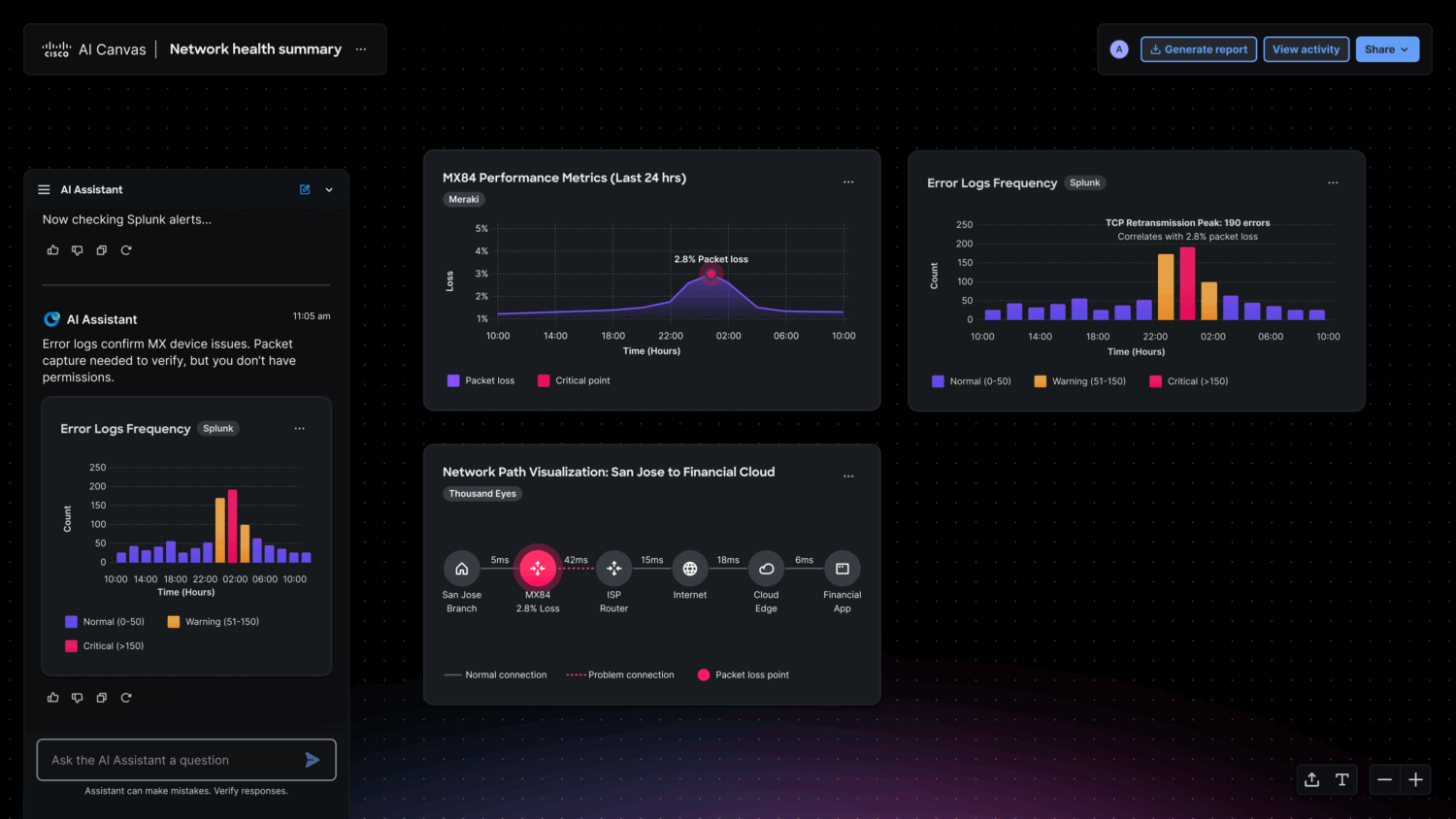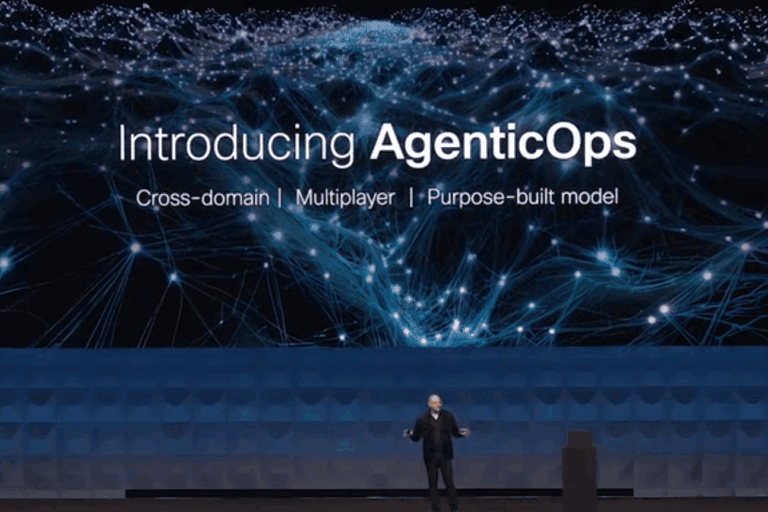We have been seeing the term AgenticOps pop up regularly lately. Cisco also mentioned it frequently during Cisco Live. Time to take a closer look. For Cisco, it is much more than just a buzzword.
The overarching message during Cisco Live is actually not much different from what we have been hearing from the company for several years. The platform, and with it the entire stack in the broadest sense of the word, is what it’s all about. Cisco is integrating its components better and better. Whether it’s the integration of Splunk and ThousandEyes for security and observability purposes, the ongoing merging of Catalyst and Meraki for campus networks, or a Unified Nexus Dashboard for data centers, there is a clear thread running through Cisco’s story.
Better integrations can be interesting in themselves, both for Cisco and for customers. However, without good management, you still won’t get the most out of it. You need insights, preferably in real time, to ensure that everything continues to run smoothly. Of course, Cisco can offer considerable insight into this with ThousandEyes Assurance, especially with the new link to Splunk. This makes it possible to provide insights at both the network and application levels. This is also in line with the overarching message mentioned earlier that Cisco is gradually tying the entire stack together.
From AIOps to AgenticOps
However, providing insights is not the end of the story. There also needs to be a way to incorporate this into a company’s operational workflow. Until recently, this often involved AIOps, where a platform uses AI to analyze telemetry, extract insights, and implement them, either automatically or manually. However, AIOps is no longer the latest and greatest in this area. We now have AgenticOps. This is the logical successor to AIOps, offering greater autonomy and, above all, better analysis thanks to underlying models. At least, that’s the story from Cisco.
AgenticOps is part of another important component of Cisco’s vision. That is that we are moving toward a world in which things no longer run at human scale, but at machine scale. Among other things, this means that there will be more pressure on organizations’ stacks and, consequently, on the people who have to ensure that everything runs smoothly. Cisco assumes that the speed at which everything passes through the stack will be so high that people will simply not be able to keep up. In order to keep all machine-generated flows running smoothly, machines will also be needed on the operational side. That is essentially what AgenticOps is.
More than just a buzzword
The above vision may still sound a bit vague and unclear. But we believe the contours of the trend toward machine scale are clearly visible. Just think of how quickly Anthropic’s open-source Model Context Protocol (MCP) and Google’s Agent-to-Agent (A2A) are gaining popularity. These technologies largely remove people from workflows (although they are still needed to ensure that AI agents stay within the lines). With AgenticOps, Cisco wants to offer AI agents for IT operations. It is not a product, but a framework.
Deep Network Model
Cisco is not rushing into AgenticOps. There is definitely more to it than just parroting a trendy new term. First of all, there is the LLM that Cisco’s AgenticOps uses. This is the Deep Network Model. This model has been trained on 40 years of Cisco data and expertise.
The Deep Network Model is therefore a model that has been built from the ground up for use in network environments. This is relevant because it inevitably means that it performs better than a general LLM. Anand Raghavan, VP Products, AI at Cisco, one of the people behind the development of AgenticOps, claims that the Deep Network Model is 20 percent more accurate than a general LLM when it comes to troubleshooting, configuration, and automation.

It also helps that the data on which the model is trained is extremely reliable, as it comes from Cisco itself. This is not just about the 40 million tokens that Cisco has fed into the model. People have also made a significant contribution to its training. Cisco experts have added more than 3,000 so-called reasoning traces to the model. These consist of highly detailed annotations that enable validation for every step and every layer of the model’s logical reasoning.
The Deep Network Model is the second specialized model announced by Cisco. Earlier this year, we wrote about the open-source AI model launched by Foundation AI, a new division of Cisco. That model focuses on security. The Deep Network Model is different from the security model because it is not open-source. This is not really relevant at the moment, as it has only been trained on Cisco data and expertise. Perhaps we will one day have a truly open network landscape, where a broader but still specialized model can be developed. After all, there are plenty of organizations that do not purchase everything from a single supplier. They too must be served in the long term.
AI Canvas
With the term AgenticOps and the underlying Deep Network Model, we have the basis for what Cisco wants to achieve. However, the company also immediately shows what is possible within the AgenticOps framework. It does this with AI Canvas. This can be seen as the place where all data from all parts of Cisco comes together in a shared environment: network, cloud, security, observability, collaboration. You can see everything here in real time. It should be the interface where people and AI agents can work together. There is also integration with the Cisco AI Assistant.

The idea behind AI Canvas is that it can query all data from this central workspace, for example for troubleshooting. If there is a ServiceNow ticket, you paste it into the AI Assistant. AI Canvas takes it from there. It retrieves data from Meraki, ThousandEyes, and Splunk and analyzes it using the Deep Network Model. You then see what is going on live, in real time, even before anyone has asked a question via the AI Assistant. It also creates the UI in which the insights are presented. For each insight, AI Canvas creates a widget with the information you need. It is then possible to call in extra help to work on it with someone else.

The power of AI Canvas does not lie so much in the fact that it brings together many different data sources. Of course, that is a plus, because you no longer have to switch between ten different tools. Based on what we have seen so far, the real power lies mainly in the seamless and, above all, active and proactive collaboration between AI agents and humans. It is not an exclusively reactive relationship in which humans ask questions via the AI Assistant and AI comes up with answers. The AI agent thinks and works actively, even when it comes to ultimately solving the problem.
AI Canvas has a lot of potential
AI Canvas is not currently intended to replace IT operations staff. A human is always involved to ensure that everything is done according to the rules. Cisco promises transparency at every step, for example about where specific data comes from. The idea is that the human employee retains ultimate responsibility while AI Canvas does the tedious and heavy work.
Ultimately, of course, the necessary agentic automation will have to take place. This is almost inevitable, otherwise you cannot respond quickly enough or intervene proactively if something goes wrong or is about to go wrong. We expect that the steps that employees have to approve will become more extensive before AI agents are given real autonomy. Even then, Cisco will have to ensure that there are people who remain in control. That will be a major challenge. We have to admit that the first demos look very promising. This bodes well for the future, in which Cisco will undoubtedly continue to work hard on AgenticOps in general and AI Canvas in particular.
